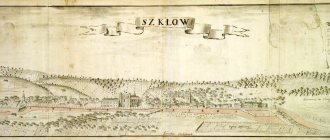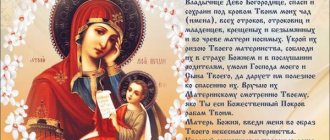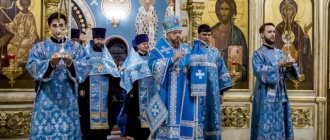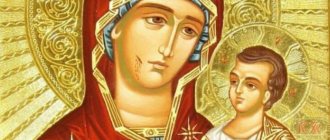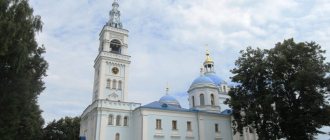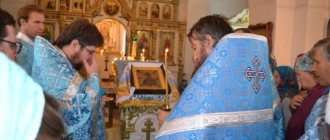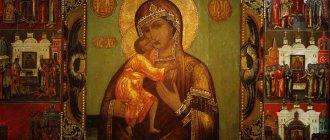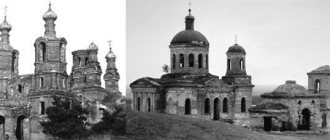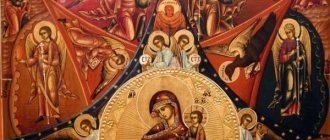[edit] Architectural features of the temple-chapel
The main building material was logs brought from the Arkhangelsk region, processed into timber.
The temple is a wooden chapel, with a high octagonal bell tower, topped with a small onion-shaped dome on a hipped base, with a gable roof, similar to cell churches [4], on the eastern side of which there is a pentagonal apse under a hipped roof.
In the central part there is a beautiful four-tiered iconostasis, reminiscent of ancient chapel structures that were used in churches of the Russian North. The frames of two large attached icons are made in the same style - the icon of the Savior and the temple icon of the Mother of God “Quench My Sorrows,” especially revered by the parishioners.
The parishioners can enter the small porch on the western side through a porch with a carved balustrade.
On May 21, 2015, the consecration of the new Cross, which crowns the onion-shaped dome, took place.
Login to the site
Where is
The temple is located in Moscow, on Vishnyakovsky Lane, 15. You can take the metro to the Paveletskaya metro station, then take the tram towards the center.
History of veneration
The current Temple was built in 1805, although before it at least two church buildings stood on this site at different times. In 1847, a refectory with a three-tier bell tower was erected.
The main altar of the Temple was consecrated in honor of the Transfer of the relics of St. Nicholas from the city of Myra in Lycia to the city of Bari, the southern limit - in the name of St. Sergius of Radonezh, the northern limit - in honor of the Entry into the Temple of the Most Holy Theotokos.
Already in Soviet times - the Temple did not close after the revolution - local veneration of Andrei Rublev ; in the early 80s of the twentieth century, a service was compiled for him and the first icon was painted (Andrei Rublev was glorified for general veneration in June 1988).
The main shrine of the Church of St. Nicholas in Kuznetskaya Sloboda is the miraculous icon of the Mother of God “Quench My Sorrows.”
It was brought to Moscow by the Cossacks in 1640 and placed in the Church of St. Nicholas the Wonderworker in Zamoskvorechye. Here they kept records of numerous miracles revealed by the icon. However, in 1771 a fire destroyed these records. Nevertheless, it is known that the icon became famous in Moscow for many miracles, for example, by praying before the icon, the plague epidemic of 1771 was stopped.
People pray at the icon “Quiet my sorrows” during life’s hardships and misfortunes.
Celebration: January 25 (old style)
February 7 (new style)
Troparion to the Most Holy Theotokos in front of Her icon called “Quench My Sorrows”
Troparion, tone 5
Assuage the sickness of my much-sighing soul, Who has quenched every tear from the face of the earth: You drive away sickness with man and destroy the sorrows of sinners, For You are the source of hope and affirmation for all. Most Holy Mother of God.
Kontakion, tone 6
The intercession of Christians is not shameful, the intercession to the Creator is immutable, do not despise the voices of sinful prayers, but advance, as the Good One, to the aid of us who faithfully call Thee: hasten to prayer, and strive to entreaty, ever interceding, the Mother of God, who honor Thee.
Prayer before the icon of the Mother of God Soothe my sorrows
The hope of all the ends of the earth and of Your servants (names), You, Most Pure Virgin, Lady Theotokos, are our consolation! Do not disdain us, sinners, for we trust in Your mercy. Quench the flame of sin in us and irrigate our withered hearts with repentance, cleanse our minds from sinful thoughts; accept the sigh from the soul and heart of those who bring you the prayer. Be an intercessor for us to Your Son and God, and tame His righteous fury with Your Mother’s prayers. Heal mental and physical ulcers, Lady Theotokos, quench the illnesses of souls and bodies, calm the storm of evil attacks of the enemy; take away the burden of our sins and do not leave us to perish until the end. For you are the builder of the human race, an ambulance in sorrow. True Mother of Christ our God, help us, Thy sinful servants always, now and ever and unto ages of ages. Amen.
The history of the icon of the Mother of God called “Quench My Sorrows”
"Quiet my sorrows." Where did this amazingly touching name of the Mother of God come from?
From the prayer texts to the icon we can conclude that the title “Quench my sorrows” is nothing more than a prayer to the Mother of God for deliverance from numerous illnesses and sorrows of the body and especially the soul, i.e. sinful passions overwhelming the heart.
In a life full of adversity, who has not experienced sorrow? Who can say about himself that in his life’s journey he did not experience difficult moments of misfortune and did not look for support or consolation from anywhere?
A Christian, despite all the difficult and sad circumstances of his temporary life, involuntarily mentally turns to where he expects help. And, indeed, it is not from people, who are also weak by nature, that he receives true medicine, but from the Lord himself through the intercession of the Most Holy Mother of God with Him.
Description of the icon:
On the icon, the Mother of God is depicted with her right hand holding the Infant Christ, in Whose hands a scroll is unfolded with the words: “Judge righteous judgment, do mercy and generosity to each of your sincere ones; Do not force a widow or an orphan, and do not create malice in your brother’s heart.” The Mother of God placed her left hand on Her head, slightly tilted to one side, as if she were listening to the prayers of all those who turn to Her in sorrows and sorrows.
History of the image of the Icon of the Mother of God “Quiet my sorrows”:
The first known icon from the 17th century, “Quench My Sorrows,” was located in the Belarusian city of Shklov. This image was brought to Moscow by the Cossacks in 1640 under Tsar Mikhail Fedorovich. However, the Zamoskvoretsky copy of the icon, located in the Church of St. Nicholas, on Pupyshi in Sadovniki, received special, all-Russian glorification. At one time, probably as a result of a fire and repeated reconstructions of the temple, the icon was forgotten; it was abandoned and was in great neglect in the bell tower. But the abundant mercies shown through her by the Mother of God forced us to remember the forgotten shrine and give it its rightful place in the church, in which a chapel was subsequently built in her honor. This church kept records of many miracles that occurred from the miraculous icon of the Mother of God. Especially many miracles happened during the plague of 1771. Later, the documentary evidence was destroyed by fire during a fire.
Tradition, however, has preserved the memory of many miraculous events, the most famous of which is the following incident, which marked the beginning of the veneration of the icon as miraculous.
One woman of noble origin, who lived far from Moscow, was bedridden for a long time, suffering from a debilitating illness. Doctors no longer hoped for her recovery, and the woman expected a fatal outcome. But one day in a dream, the sick woman saw the Mother of God, who told her: “Tell yourself to be taken to Moscow. There, on Pupyshev, in the Church of St. Nicholas, there is My image with the inscription: “Quench my sorrows,” pray before it and you will receive healing.”
The woman shared what she had seen with her relatives, and with deep faith everyone set off on a difficult journey for the sick woman and, upon arrival in Moscow, found the indicated temple. However, having examined the entire church, the arrivals did not find the image that appeared to the woman in a dream. Then the priest, to whom the sick woman turned for advice, ordered the clerks to bring all the icons of the Mother of God from the bell tower. Among the dilapidated and dusty icons brought, they found an icon of the Mother of God with the inscription: “Quench my sorrows.” Seeing him, the patient exclaimed: “She! She!" - and, who had not previously had the opportunity to even move her hand, to the surprise of everyone, she crossed herself. After the prayer service, the woman venerated the icon and rose to her feet completely healthy. This healing took place on January 25, 1760. Since then, it was established on this day to celebrate a festival in honor of the icon of the Mother of God “Quench my sorrows.” The service with an akathist, first published in 1862, also dates back to that time.
In addition to the miraculous icon of the Mother of God, in the Church of St. Nicholas you can venerate his other shrines: the revered icon “Seeking the Lost,” the Temple Icon of St. Nicholas with the Life, written in the 17th century.
Source
Icons of the Mother of God. Soothe my sorrows (Orthodox conversations No. 1/2010)
November 20, 2010
4
Categories: No. 6, No. 1 / 2010 (“VZ” No. 6 / 2010)
Icons of the Mother of God. Soothe my sorrows (Orthodox conversations No. 1/2010)
Icon of Soothing Sorrow Ekaterinburg
The miraculous icon of the Mother of God, called “Quench My Sorrows,” became famous in Zamoskvorechye, in the Church of St. Nicholas in Pupyshi. Unfortunately, the icon has not survived, the temple has not survived either, but the especially revered copy of this image, marked by many miracles, is the main shrine of another Zamoskvoretsk church - in the name of St. Nicholas in Kuznetsy.
In the icon, the Mother of God is depicted holding with her right hand the Infant Christ, who is holding an unrolled scroll in his hands. The Mother of God placed her left hand on Her head, slightly tilted to one side, as if she were listening to the prayers of all those who turn to Her in sorrows and sorrows.
“Quench my sorrows”... Where did this amazing, childishly touching name come from?
Very often the names of icons glorified in the last three centuries come from some kind of prayer texts.
For this icon, the closest correspondence is found in the following stichera of the Theotokos: “Quench the sickness of my much-sighing soul, which has quenched the tears from the face of the earth. You drive away sickness from a man, and destroy the sorrow of a sinner. You have all the hope and affirmation, Most Holy Mother of the Virgin.”
And indeed, many lists of icons bear the signature “Image of the Most Holy Theotokos Quench Illness,” or “Quench Illness and Sorrow.” But still, in this form the name is far from the original. On the oldest lists the inscription is different - “The Satisfied Most Holy Theotokos.” This is what the icon was called in the 18th century. And on one engraving of that time depicting our icon, its name is explained as follows: “The image of the Most Holy Theotokos, Quenched, quenches cruel wounds and rules human hearts.”
“quenchable” means “quenching”, taming. And, therefore, the Mother of God was asked to quench not only sorrows and illnesses, but also human hardness. This meaning perfectly corresponds to the inscription on the icon from the Church of St. Nikola in Pupyshi. We read it on the scroll held in the hands of the Infant Christ: “Judge righteous judgment, and do mercy and generosity to everyone who is sincere, and do not force the widow, the sire, the stranger, the wretched, and do not remember the malice of your brother.”
.
On all other known copies of the icon, this inscription is either shortened or completely changed. It represents a little-known passage of Holy Scripture - the beginning of the third chapter of the book of the prophet Zechariah, and extracted from the text of the Ostrog Bible. In the Elizabethan Bible, published in the mid-18th century and officially adopted by the Synodal Church, this place is read differently - clear evidence that the icon from the Church of St. St. Nicholas in Pupyshi was copied from an older image. It should be noted that these words of the prophet Zechariah were included in the book of church teachings - Prologue. The “Word of the Prophet Zechariah to the Unmerciful Princes,” published on September 5, begins with them. Perhaps these words became known to the ancient icon painter from the teaching. And then the meaning of the name of the icon is revealed even more: “quenchable” - the quenching cruelty of the “unmerciful princes”, proud conquerors. It seemed to express the pain and prayer of Little and White Rus', which in the 17th century bitterly suffered from incessant violence and robberies - Polish, Moscow, Cossack, Tatar...
Another version of this name is also known: “Quench the Sorrows” or “Quench the Sorrows.” It is not difficult to guess that it was from the last form of this name that the later one came - “Quench my sorrows.”
This icon is found, as icon painters say, in several “versions.” The Mother of God is represented facing either the right or the left with slightly different hand positions. The Baby Savior either seems to be sitting, or almost lies on Her lap or in the cradle, but the cradle itself is not visible, and He seems to be floating in the air. The scroll in the hands of a baby is an indispensable detail of the icon, but on different icons we read different inscriptions on it. What is the reason for such differences? And which of this many icons was glorified as miraculous?
The first known icon from the 17th century, “Quench My Sorrows,” was located in the Belarusian city of Shklov in the Church of the Resurrection of Christ. In the old days there was a convent here, and legends about the origin of this icon were probably kept among nuns. The fame of the icon extended far beyond the borders of the Mogilev region. In the 18th - early 19th centuries, even printed sheets with her image were published. But subsequently the small Shklov monastery fell into decay, became depopulated and in 1840 was converted into a parish church. Local residents still revered the icon of the Mother of God, but did not know its history.
In the 1650s, copies of the Shklov image of the Mother of God “Quench My Sorrows” appeared in Moscow. Usually, in old books describing the famous Mother of God icons, it is said that the icon was brought to Moscow by certain Cossacks either in 1640, or, as others believe, “during the reign of Alexei Mikhailovich.”
It is more logical to date the transfer of the icon to 1654-55. Russian-Polish War. In September 1654, Shklov was taken by the troops of Alexei Mikhailovich. The Cossacks took icons, rare for Great Russia, from the city as trophies. Such icons, like other shrines, were collected with special care by the royal family. And, probably, it is no coincidence that the oldest of the Moscow icons of the Most Holy Theotokos that have come down to us, “Quench My Sorrows,” belongs to the brush of one of the royal icon painters of the second half of the 17th century. She was in the church of St. Tikhon of Amafuntsky on Arbat Square - near the settlement where these masters lived. Now it can be seen in the Church of the Resurrection of the Word (Apostle Philip) in Filippovsky Lane. As authors of the last century write, this icon has long been known throughout Moscow and attracted those burdened with everyday sorrows. It was considered the most accurate and oldest copy of the original miraculous icon located in the Resurrection Monastery in the city of Shklov.
However, another copy of the icon, Zamoskvoretsky, received special, all-Russian glorification. Since the 17th century, the image has been in the Church of St. Nikola on Pupyshi, brought by the Cossacks. For some reason, this icon was removed from the bell tower.
She was forgotten for a long time, until some miraculous incident served to rediscover her. Far from Moscow there lived a noble woman. In the earliest records of the legend, she is called the noblewoman. For many years her body was paralyzed. The patient no longer had any hopes for medical help; All she had left was a prayer to God and the Intercessor of all those who mourn - the Most Holy Theotokos Mary. Brought to the point of complete exhaustion by illness, she no longer hoped to recover. Various medical remedies did not bring her the desired healing. One day, when the patient was unconscious, she saw an icon of the Mother of God unknown to her and heard a voice from her: “Tell me to take you to Moscow. There in Pupyshov, in the Church of St. Nicholas, there is an image “Quench my sorrows,” pray in front of it and you will receive healing.”
Having awakened, the noblewoman was able to remember and call home the church where she should have gone. But when she was brought to the Church of St. Nicholas on Pupyshi, the icon seen in the dream was not there. They forcibly remembered that the old images had long been removed from the bell tower. The priest ordered them to be brought. And so, before they had time to wipe off the dust from the face of the Mother of God, the patient loudly exclaimed: “She!” - and began to cross herself with a hand that she could not move just a minute ago. And after a prayer service was performed in front of the icon, the woman stood on her feet for the first time in many years.
This story was transmitted orally in Moscow until 1869, when it was first published in the Moscow Diocesan Gazette. In this first publication, the miraculous appearance of the icon is attributed to the second half of the 18th century; it turns out that the icon was removed to the bell tower only 20-30 years after it was given to the church.
In 1760, a special chapel was built in the church in the name of this miraculous icon and an annual celebration was established on January 25. Many believe that on this day the miracle of the noblewoman’s healing took place. But Rozanov’s “History of the Moscow Diocesan Administration” suggests another reason for choosing this day. In 1760, the Sunday chosen by Moscow Metropolitan Timothy for the consecration of the chapel fell on January 25. The day of the consecration of the temple remained the day of its patronal feast, and later began to be perceived as a day of celebration of the icon itself. In the 1930s, after the closure of the temple, the image was moved to another Zamoskvoretsk church, also Nikolskaya, on the corner of Novokuznetskaya street and Vishnyakovsky lane, where it remains to this day. At the first glance at this icon, one has to doubt that it could have been brought to Moscow in the middle of the 17th century. Experts in icon painting confidently attribute its creation not to the 17th century, but to the second half of the 18th century. Already in our time, in an article about the icon published in the Journal of the Moscow Patriarchate, priest Alexander Kulikov suggested that the icon “Assuage My Sorrows” that has survived to this day is a copy of the original miraculous icon. It was written specifically for the newly built chapel.
Why was a new list written? Because of the dilapidation of the old? This is unlikely. Knowing the attitude of Russian people towards miraculous and revealed icons, it is difficult to agree with this. An old, but famous miraculous icon could be renewed by writing, clothed in a robe, placed in an icon case, but, in any case, they would not deliberately replace it.
It is possible that in the icon the hand of the Mother of God was folded into a two-fingered sign. And since the end of the 17th century, the authorities have been diligently fighting with old icons, painted before Nikon’s reform. In 1758, a decree of the Synod was issued, appointing special commissions to examine icons in all churches and monasteries. “Unskilfully painted” icons, that is, depicting the double-fingered addition, were ordered to be removed, “putting in their place others, again painted with skillful work.”
In any case, a list was made from the icon, which was placed in the chapel of the St. Nicholas Church in Pupyshi. This temple kept written evidence of numerous miracles, through the prayers of the Mother of God from Her miraculous image. Especially many miracles happened during the plague of 1771. This evidence was later destroyed by fire during a fire.
Revered copies of the icon of the Mother of God, called “Quench My Sorrows,” are found in many churches in Moscow (and other cities), these are the Moscow churches of St. John the Baptist, on Pokrovka, the Holy Apostles Peter and Paul on Novaya Basmannaya, St. Sergius, on Rogozhskaya, the already mentioned Resurrection of the Word in Filippovsky Lane, the Transfiguration of the Savior on Bolvanovka (Zamoskvorechye), etc.
In 2001, a very beautiful temple of the “Quench My Sorrows” icon was built in Maryino.
As for our Nikolo-Kuznetsk Church, here the feast of the icon, February 7, is always celebrated very solemnly. This holiday is especially important for parishioners and for teachers and students of the Orthodox St. Tikhon's Humanitarian University; students have a tradition: before starting classes, they go into the temple to venerate the miraculous image.
This year coincided with the celebration of the icon of the Mother of God “Assuage my sorrows” and the memory of the new martyrs and confessors of Russia, in whose glorification the Orthodox St. Tikhon’s Humanitarian University takes an active part.
Icon of Soothing Sorrow Zamoskvorechye
And I would like to finish the story about this icon with the words of Patriarch Alexy II, which he said on his last visit to the Nikolo-Kuznetsk Church, in 2007, at a festive service:
“Today the Church celebrates the day of the venerated image of the Queen of Heaven, “Quench my sorrows.” And if you ask each of us whether we have had any sorrows or sorrows, then everyone will answer in the affirmative. But by resorting to the Mother of God and praying to Her in front of Her icon, we invariably receive satisfaction, relief from our sorrows and life’s difficulties. We ask Her to help us not only resolve certain personal problems, but also patiently bear sorrows, carry our life’s cross, trusting in the mercy of the Lord and the intercession of the Mother of God. There is no cross higher than human strength, but in each one’s carrying his life’s cross, in sorrows, among all kinds of adversity, we always have a gracious helper and prayer book in the person of the Mother of God. For centuries, Orthodox Christians have resorted to Her with their sufferings and sorrows, and She never leaves anyone without Her gracious support and guidance.”
Galina Semyonova
In photo 1 (above) - the icon of the Most Holy Theotokos “Quench my sorrows”, late 19th - early 20th centuries, Church of All Saints, Yekaterinburg
In photo 2 - the icon of the Most Holy Theotokos “Quench my sorrows”, 2nd half of the 18th century, Church of St. Nicholas in Kuznetsy
In photo 3. -
Church of St. Nicholas in Pupyshi
Church of St. Nicholas in Pupyshi stood on Pupyshevskaya embankment, now Kosmodamianskaya embankment, vl. 40-42. On September 17, 1932, the temple was closed and its dismantling began. But in the beheaded and dilapidated temple, a dormitory for horse transport workers was located. After the construction of the modern house No. 40/42, the temple building ended up in the courtyard of the house and was finally dismantled in 1969-1970.
